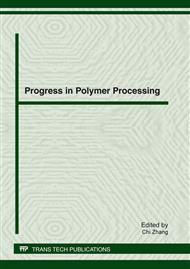p.453
p.457
p.463
p.467
p.473
p.479
p.484
p.489
p.495
Effect of Post-Vulcanization on the Tire Curing Degree
Abstract:
The optimum curing times for rubbers used at various parts of a tire are measured under different temperatures. The sulfurization reaction activation energies for various kinds of rubbers are obtained based on Arrhenius’ law and the equivalent tire curing time and curing degree are calculated with or without taking post-valcanization effect into consideration. It Is found the post-valcanization effect has significant effect on the rubber curing degree and therefore can not be ignored. Attentions have to be paid on the post-valcanization effect for quality and efficiency enhancement of tire production.
Info:
Periodical:
Pages:
473-478
Citation:
Online since:
January 2012
Authors:
Price:
Сopyright:
© 2012 Trans Tech Publications Ltd. All Rights Reserved
Share:
Citation:


